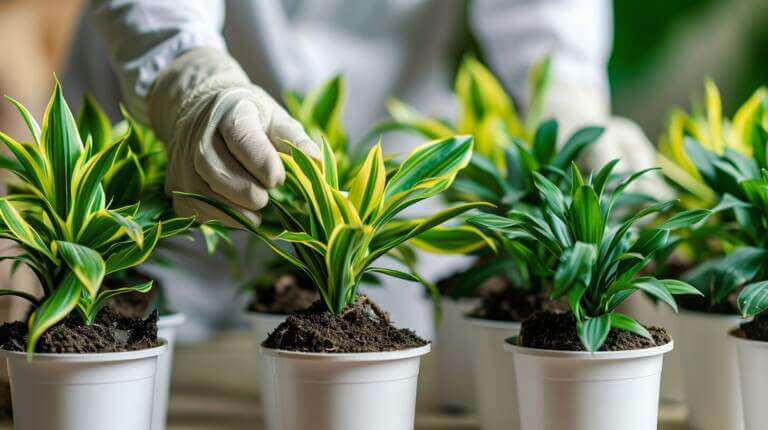How to Propagate Fiddle Leaf Fig from a Cutting: Step-by-Step Fiddle Leaf Fig Propagation Guide
Propagating a fiddle leaf fig plant is an easy and cost-effective way to grow multiple plants from one original plant. By taking stem or leaf cuttings and allowing them to root in water or soil, you can create new self-sustaining plants. The best time to propagate your fiddle leaf fig is in the spring when the plant is naturally prone to new growth. In this step-by-step guide, you will learn how to successfully propagate your fiddle leaf fig from a cutting.
Key Takeaways:
- Propagating a fiddle leaf fig allows you to save money and clone your favorite plant.
- There are two main methods for propagating a fiddle leaf fig: in water or in soil.
- To propagate your fiddle leaf fig, follow the steps of preparing the propagation container, taking a stem cutting, using rooting hormone, placing the cutting in a bright location, and monitoring water levels.
- Consider tips such as choosing a healthy stem cutting, keeping the water clean and at room temperature, and using a well-draining soil mix for planting.
- The propagation process can take several weeks to a few months, and proper care and maintenance are essential for successful growth.
Why Propagate Your Fiddle Leaf Fig Cutting?
Propagating your fiddle leaf fig plant can have multiple benefits. Not only does it allow you to save money by growing new plants from cuttings, but it also gives you the opportunity to clone your favorite fiddle leaf fig. This means you can reproduce the characteristics and traits of your beloved plant and have multiple specimens throughout your home or garden. Whether you want to create a stunning indoor jungle or share the beauty of the fiddle leaf fig with friends and family, propagation is a simple and rewarding process.
Here are reasons why propagating your fiddle leaf fig can be beneficial:
- Multiplies your plant – Propagation allows you to grow new fiddle leaf figs from just a single cutting, essentially cloning your plant.
- Saves money – Growing new fig trees through propagation is free compared to buying new plants.
- Preserves special varieties – Propagate to create genetically identical plants with unique leaf shapes, sizes, or variegation.
- Encourages bushiness – Pruning a stem for a cutting encourages your fiddle leaf fig to branch out.
- Allows sharing – Rooted cuttings make great gifts for fellow plant lovers. Share varieties you have propagated.
- Provides insurance – Take cuttings to create backups in case your main plant gets damaged or diseased.
- Controls size – Starting new small plants from cuttings lets you control the size better than a fast-growing mature tree.
- Promotes learning – Propagating develops new gardening skills and the satisfaction of growing plants from cuttings.
- Determines viability – If a cutting roots, it confirms your fiddle leaf fig plant is healthy enough to propagate from.
- Creates fullness – A bushy, full fiddle leaf fig tree can be cultivated over time by continually propagating and pruning.
- Prevents shock – Newly bought fiddle leaf figs go through transplant shock but propagated plants do not.
The advantages of propagating are plentiful! Follow simple steps to multiply your fiddle leaf fig collection.
Fiddle Leaf Fig Propagation Methods: Water or Soil?
When it comes to propagating your beloved fiddle leaf fig (Ficus lyrata), you have two primary methods: water propagation and soil propagation. Each approach has its merits, and understanding the differences will help you successfully grow new fiddle leaf fig plants. Let’s dive into the details!
Water Propagation
Water propagation is the most common and straightforward method. It’s especially suitable for plants like Pothos, some Philodendron, and Monstera. Here’s how to do it step-by-step:
- Take a Cutting:
- Use clean scissors or shears to cut a healthy stem from your fiddle leaf fig. Make sure the cutting has a node (the point where leaves emerge).
- Place in Water and Wait:
- Submerge the cutting in a container of water, ensuring that the node is submerged.
- Wait patiently for roots to develop. This usually takes a few weeks.
- Repot:
- Once the roots are about two inches long, transplant the cutting into well-draining soil.
- Keep the soil moist during the initial weeks, as the plant is accustomed to water.
Tip: Use distilled water or let tap water sit out overnight to remove chlorine before using it for water propagation.
Soil Propagation
Soil propagation involves planting the cutting directly into soil. Here’s how to do it:
- Prepare the Cutting:
- Take a cutting with a node, just like in water propagation.
- Choose the Right Soil:
- Use a well-draining soil mix suitable for houseplants.
- Make sure the soil is slightly dampened.
- Plant the Cutting:
- Place the cutting into the soil, ensuring the node is buried.
- Support the cutting with stakes if needed.
- Care and Patience:
- Keep the soil moist, but avoid overwatering.
- Place your cutting in a bright, indirect light spot.
- Over time, the cutting will grow new roots and develop into a new plant.
Which Fiddle Leaf Fig Plant Propagation Method Is Best?
- Water propagation is easier and requires less effort and skill.
- Soil propagation provides a more stable environment for root development.
- Choose based on your preference and the specific needs of your fiddle leaf fig.
Remember, whether you’re a seasoned plant parent or a beginner, propagating your fiddle leaf fig is a rewarding journey. Happy growing! 🌱🍃
Steps to Propagate Your Fiddle Leaf Fig Stem Cutting
If you’re ready to propagate your fiddle leaf fig and create new plants, follow these simple steps:
- Prepare your propagation container by filling it with clean, chlorine-free water. This will provide a suitable environment for root development.
- Take a stem cutting from your fiddle leaf fig. Choose a healthy stem with 2-3 leaves and make the cut about 3 inches below the first leaf. This will give the cutting the best chance of success.
- Dip the bottom end of the cutting in rooting hormone. This will encourage the development of strong roots.
- Place the cutting in a bright location, away from direct sunlight. A well-lit spot near a window is ideal.
- Check the water level in the propagation container every few days and replace it with clean water if necessary. This will ensure that the cutting has the moisture it needs to develop roots.
- Be patient and wait for about one month for the roots to develop. You may see small white roots starting to appear at the bottom of the cutting.
- Once the roots are about 1-2 inches long, it’s time to plant the cutting in moist potting soil. Choose a well-draining soil mix to prevent waterlogging.
- Keep the soil evenly moist for the first two months to help the new plant establish itself. Monitor the moisture level and water as needed.
- After three months, you can start fertilizing the new plant to promote growth. Use a balanced liquid fertilizer and follow the instructions on the package.
This step-by-step process will help you successfully propagate your fiddle leaf fig from a cutting. Remember to keep the cutting in a bright place, use rooting hormone, and provide the necessary care to ensure the best chances of success.
| Step | Description |
|---|---|
| 1 | Prepare propagation container with clean water |
| 2 | Take stem cutting with 2-3 leaves |
| 3 | Dip cutting in rooting hormone |
| 4 | Place cutting in bright location |
| 5 | Check water level every few days |
| 6 | Wait for roots to develop |
| 7 | Plant rooted cutting in moist potting soil |
| 8 | Keep soil evenly moist for first two months |
| 9 | Fertilize regularly after three months |
Propagate Fiddle Leaf Fig Timeframe
When propagating a fiddle leaf fig from a cutting, it’s important to understand the timeline of the propagation process. The time it takes for roots to develop and for the new plant to establish can vary, but generally, it can take several weeks to a few months.
Materials Needed Propagate A Fiddle Leaf Fig Tree
- Fiddle leaf fig plant: A healthy fiddle leaf fig plant is essential for successful propagation.
- Pot: A well-draining pot is necessary for the new plant.
- Potting soil: A well-draining soil mix is crucial for root development.
- Rooting hormone: This helps stimulate root growth in the cutting.
- Water: Tap water or distilled water can be used for water propagation.
Steps to Propagate Fiddle Leaf Fig
- Take a Cutting: Choose a healthy stem on your fiddle leaf fig plant with several leaves. Cut the stem at a leaf node using a clean, sharp tool.
- Prepare the Cutting: Remove the leaves at the bottom of the stem cutting, leaving only a few leaves at the top. Dip the end of the cutting in rooting hormone.
- Rooting the Cutting: You can choose to root the cutting in water or soil.
- Water Propagation: Place the cutting in a container with water. The water level should cover the nodes but not the leaves. Change the water every week to prevent bacteria growth. It’s easy to propagate this way as you can observe the root growth.
- Soil Propagation: Plant the cutting in a pot with moist potting soil. Keep the soil moist but not soggy. This method is beneficial as it avoids the shock of transferring from water to soil.
- Wait for Root Development: This is the most crucial step in the timeframe for propagation. It can take several weeks for new roots to grow. Be patient and make sure to keep the cutting in a warm place with indirect light.
- Plant the Rooted Cutting: Once the cutting has developed a robust root system, it’s time to plant it in soil. Use a well-draining soil mix and a pot that supports the cutting. Keep the soil moist and place your new fiddle leaf fig plant in a location with bright, indirect light.
- Care for Your New Plant: Continue to water your new fiddle leaf fig plant regularly, but make sure not to overwater. Watch for new growth as an indication that your plant is thriving.
FAQ
Why should I propagate my fiddle leaf fig?
Propagating your fiddle leaf fig allows you to save money and clone your favorite plant. It is a cost-effective way to grow multiple plants from one original plant.
Can I propagate my fiddle leaf fig in water or soil?
Yes, you can propagate your fiddle leaf fig using both water and soil methods. The process and care requirements may vary slightly between the two methods.
How do I propagate my fiddle leaf fig from a cutting?
To propagate your fiddle leaf fig, you will need to prepare a propagation container with clean water or well-draining soil. Take a stem cutting with 2-3 leaves, dip it in rooting hormone, and place it in a bright location without direct sunlight. Wait for the roots to develop before planting the rooted cutting in soil.
What are some tips for successful propagation?
Choose a healthy stem cutting with new growth, use a rooting hormone to encourage root development, place the cutting in a bright location without direct sunlight, keep the water clean and at room temperature, use a well-draining soil mix for planting, keep the soil evenly moist for the first two months, and prune and shape your fiddle leaf fig to promote new growth.
How long does it take to propagate a fiddle leaf fig from a cutting?
The propagation process can take several weeks to a few months. It usually takes about 3-4 weeks for roots to start developing in water. Once the roots are about 1-2 inches long, you can plant the cutting in soil. It may take a year or more for your new plant to fully establish and start growing new leaves.
How do I troubleshoot and maintain my propagated fiddle leaf fig?
Regularly check the water level and maintain a bright but indirect light location. If the leaves start to droop or turn yellow, it may be a sign of overwatering or insufficient light. Pruning your fiddle leaf fig can also help promote new growth and prevent legginess. Follow proper care guidelines for your propagated plant to ensure its health and successful growth.







